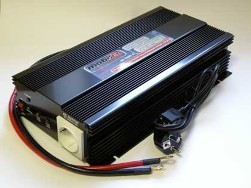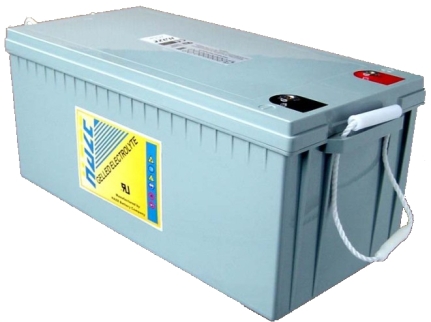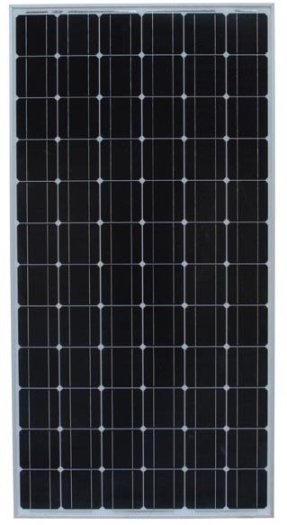Categories: Featured Articles » Autonomous power supply
Number of views: 15331
Comments on the article: 0
Choosing an inverter and calculating the battery for a home solar power station
 In the article "An example of calculating solar panels for the home" we got the daily consumption value - 7919.8 W * hour and the amount of energy needed to cover the daily needs of the devices we listed - 396 A * hour.
In the article "An example of calculating solar panels for the home" we got the daily consumption value - 7919.8 W * hour and the amount of energy needed to cover the daily needs of the devices we listed - 396 A * hour.
Let's do a classic calculation of the entire solar power supply system, including the solar battery. I want to warn you right away, in this calculation I did not pursue the goal of minimizing economic indicators (we will deal with this later), but only set the task to show the calculation procedure.
Inverter selection
Based on the list of devices that we listed, we can decide on the main parameters inverter for our system.
Firstly, since the list of devices contains devices that include engines: an electric pump, a refrigerator, a washing machine, a vacuum cleaner, we can certainly and should talk about an inverter with a sinusoidal voltage output rather than a quasi-sinusoid.
Secondly, the input voltage of the inverter must correspond to the voltage chosen by us - 24V.
As for power, its choice depends on how you agree to use your devices. If you consider it necessary to simultaneously operate energy-intensive devices, such as a washing machine, microwave, iron and all this against the background of a working refrigerator, then you will have to add up their rated capacities.
You will receive peak power, which will determine the power of the inverter (minimum 5 kW), but you yourself understand that if you do not use these devices at the same time, then the power of the inverter will be less, so its price will be lower. You decide.
Given the agreed list of devices and distributing their use over time, we could restrict ourselves to a 3.0 kW inverter: manufacturer OutDack Power Technologies, a model with an integrated charger: GVFX3024E, Grid-Interactive GVFX3024E Vented 3000 W, 24 V, 80 A (average cost of 99500 rubles).
See also on this topic:Inverter: sine wave or modified sine wave?

Battery calculation
Now let's talk about batteries. We already know about the purpose of batteries from the article “Batteries for solar cells". It is only necessary to decide how we use the house. If you arrive on weekends, accordingly, the main electricity consumption will be carried out on weekends. But its accumulation, i.e. the batteries will be charged all week - from Monday to Friday evening. For example, I come to my house on weekends.
We will provide energy reserve for one day. Why you are alone? Because for five days of my absence, the probability of a full charge of the batteries is quite high. It is possible to provide a guaranteed energy reserve for two days, but this is possible by increasing the total capacity of the batteries, and hence the cost of the entire system.
It is advisable to limit yourself to one day, and when the cost of the entire system is outlined, play with the picking options and look at the cost reaction.
There are a few more things to consider.
First: the fact is that discharging batteries to a large “discharge depth" is the same as making them unusable with their own hands (the service life is reduced significantly). You should focus on the 20 percent discharge depth.
Second: from the point of view of safe operation, it is best to use sealed batteries, since unpressurized batteries emit harmful to breathing and explosive gases. Despite the use of sealed batteries, I would recommend that you choose a room that is well ventilated for their installation.
Third: in terms of performance for an autonomous system, the most suitable type of battery, although not the cheapest gel batteries (GEL).
And the last one. The ambient temperature should also be taken into account when calculating the required battery capacity if batteries have to be operated in cold periods.
At low ambient temperatures, the battery capacity decreases, i.e. reduced energy intensity, which the battery is able to give at a given temperature. This means that when calculating the required capacity of the battery (or batteries), you should increase the calculated value of the capacity in order to create a reserve in case of its decrease.
In simple words, you should multiply the calculated capacity by the coefficient corresponding to the temperature:
-
26.7С - coefficient = 1.00;
-
21.2C - coefficient = 1.04;
-
15.6С - coefficient = 1.11;
-
10.0C - coefficient = 1.19;
-
4.4C - coefficient = 1.30;
-
-1.1C - coefficient = 1.40;
-
-6.7C - coefficient = 1.59.
So. I chose one day to ensure a guaranteed energy reserve: 396 A * h x 1 = 396 A * h.
We take into account the depth of discharge: 396 A * h: 0.2 = 1980 A * h.
Since I operate the system only in the summer period (we are talking about the temperature of the environment): 1980 A * h x 1.00 = 1980 A * h.
Thus, the total capacity of the battery (or batteries) is 1980 A * h.

Suppose we chose a GEL battery, made by Haze, model HZY 12-200 (average cost of 18500 rubles). Its nominal capacity is 200 A * h. Let's calculate how many batteries will be connected in parallel: 1980 A * h: 200 A * h = 9.9 pcs.
We round up (always round up, even if the decimal place is less than five) - 10 pieces of batteries will be connected in parallel.
Find out how many batteries will be connected in series. For this, we select the system voltage (24 V) divided by the voltage of one battery: 24 V: 12 V = 2.
Well, we find out how many total batteries will be included in the system battery: 10 x 2 = 20.
We got the total number of batteries needed to assemble the battery for the system: 20 pieces.
Battery connection in series-parallel. In this case, this means that the batteries must be connected in pairs in series (ten such pairs), and in turn, these ten pairs are connected in parallel.
We calculate the composition of the solar battery.
Suppose we choose a solar module 200 W, 24 V, single-crystal, manufactured by Chinaland Solar Energy, model: CHN200-72M (average cost of 17500 rubles).

To calculate the solar battery, you must first determine the solar insolation of the region where the system will be operated. You can find data on insolation on the Internet. You can find by the query “monthly and annual solar radiation kW * h / m2” in Yandex.
For example: if you take Moscow (or a city at a latitude of Moscow 55.7), the period of operation is from March 1 to September 31, the slope of the panel is 40.0 degrees. Naturally, from the whole range of values from March to September inclusive, I choose the lowest value, i.e. the worst of all. This September is 104.6. I divide this number by the number of days in a month: 104.6: 30 = 3.49
Thus, we obtained the average value of the number of sunny peak hours.
Let me remind you, our daily requirement is 7919.8 W * hour.
Losses on charge-discharge will be no more than 20%, we must take them into account: 7919.8 W * hour x 1.2 = 9503.76 W * h.
Hence, the power of the solar battery should be: 9503.76 W * h: 3.49 = 2723.14 watts.
Now we can determine the number of modules connected in parallel, taking into account their type, which we selected earlier. To do this, in the indicated characteristics of the modules we find the parameter peak power of the module at the maximum power point (or the voltage at the maximum power point and the current at the maximum power point and multiply them).
In our case, the voltage at the maximum power point is 38.8 V, the current at the maximum power point is 5.15 amperes. Multiply them and get the maximum power at the point of maximum power: 38.8 V x 5.15 A = 199.82 watts.
That is, the module power at the maximum power point is 199.82 watts. Divide the power of the solar battery by this indicator of the module and get the desired value: 2723.14 W: 199.82 W = 13.63 pcs.
The number of modules connected in series (the system voltage chosen by us - 24 V is divided by the rated voltage of one module - 24 V): 24 V: 24 V = 1
We multiply the number of modules connected in parallel and the number of modules connected in series and this determines the total number of modules: 13.63 x 1 = 13.63 pieces
Again, round up. Thus, the number of solar modules should be 14 (connected in parallel).
Not yet a conclusion
We have done the calculation of the solar system, but it is still too early to draw conclusions. I did not pursue the goal of minimizing the cost of the entire system in this particular article. For this reason, it makes no sense to calculate the result of its value.
And yet, let's count, this will help us in the future to navigate in the choice of operating modes, in the choice of equipment, in the set of consumers with already applied calculations, and not theoretical:
-
Inverter - 99500 rubles;
-
Batteries - 18500 rubles x 20 = 370000 rubles;
-
Solar modules - 17,500 rubles x 14 = 245,000 rubles.
That is, the main equipment will cost 714500 rubles. Plus materials, plus overhead, etc. The order of numbers is clear. This is for a full-fledged system that will allow, without practically denying anything to itself, to operate the house from March to September, not only on weekends.
As for the winter period, I deliberately did not begin to talk about it now, because I had my own opinion on this matter. We will discuss this topic with you.
Boris Tsupilo
See also at bgv.electricianexp.com
:
